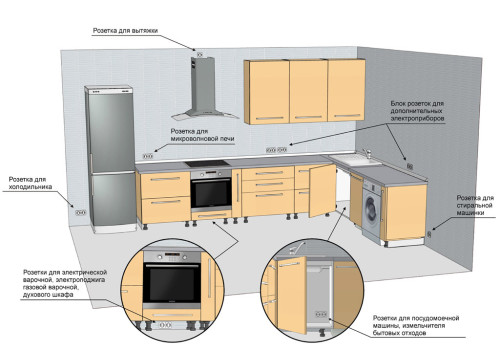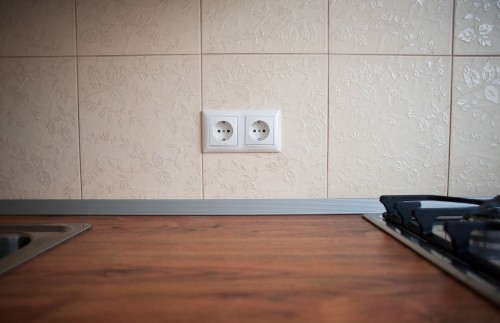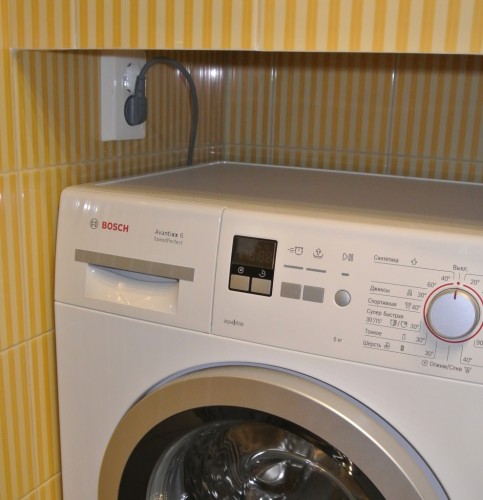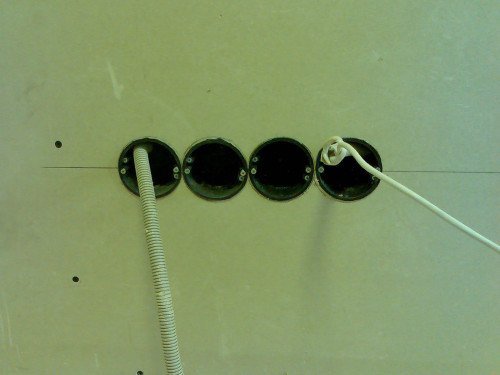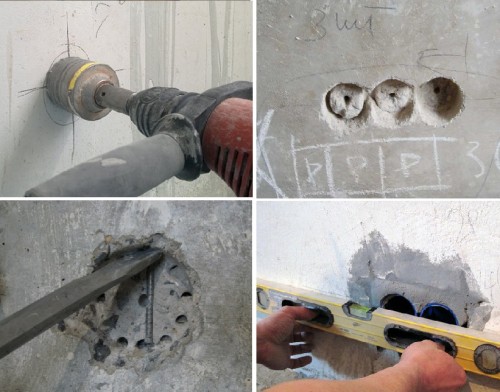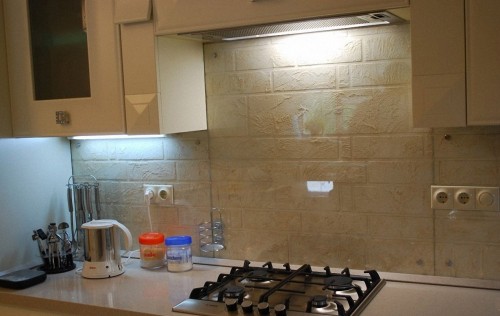Modern kitchen is a room in which not only engage in the preparation of delicious dishes. Now there are many household appliances in the kitchen, which largely influenced the increase in the amount of electricity consumed. For this reason, close attention should be paid to the optimal location of sockets in the kitchen.
Content
Rules location sockets
Naturally, the scheme of the location of sockets in the kitchen should be drawn on paper and mark the location of each electrical instrument. At the same time, it is necessary to take into account a number of mandatory requirements for the installation of electrical fittings.
Here are the main of them:
- the length of the cable that connects the rosette with the device must be within 1-1.5 m;
- installation of sockets per kitchen table is carried out at an altitude of 8-10 cm above the surface of the floor covering;
- outlets intended for small devices can be fixed on apron at a distance of 1-1.2 m from the floor;
- hood fittings are mounted at 0.5-0.6 m from the top of the cabinet;
- the distance from the rosette to the exhaust should be 0.2-0.3 m;
- ventilation system of drawing should not close the sockets;
- if the accessories are mounted inside the cabinet under the sink, then it must be moisture-resistant (IP44 marking);
- built-in rosettes for the kitchen are attached to the partition of Tumb, located near the electrical appliances, at an altitude of 0.3-0.6 m from the floor;
Forbidden to engage in the installation of sockets:
- above the gas or electric stove;
- over washing;
- behind retractable furniture;
- behind the body of household appliances.
Installation of outlets in the kitchen is carried out in such a way that:
- do not damage communication systems in the house (water supply, ventilation, gas pipeline);
- they were beyond the reach of young children.
In the presence of built-in furniture (for example, a corner or kitchen wall), the use of internal sockets will be the best option. Installation of accessories is carried out inside the structures, which makes it imperceptible.
In addition to sockets for constantly used household appliances, spare fittings should be installed. It will be enough that will be 3-4 sockets that can be used for the work of the blender, vacuum cleaner or charging a mobile phone.
You should also think about installing the uninterruptible power supply unit for power outlets that feed the electrical energy refrigerator, stove and extract.
Mounting work
Now directly to how to install sockets in the kitchen. It is worth noting that the nuances of the installation work depend on the two main factors:
- type of household appliances;
- the material from which the walls are made.
The impact of a certain factor will consider on several examples.
Connect sockets for washing machine
To connect a washing machine and other household appliances, which is characterized by an increased power, a three-contact socket is used and, accordingly, the three-core wire (ground-phase-zero).
Powerful household appliances required:
- connects to the UZO;
- equipped with a separate line with a current of 10 mA;
- it is connected to the protective machine, which is recommended by the manufacturer of the device.
It is forbidden to connect a washing machine using an extensionist stretched out of another room. To maintain normal heat transfer, it is better to use an overlap outlet than hidden fittings. The most suitable sockets for powerful home appliances are ABV, Prodax and Legrand brands.
Connecting sockets for TV and computer
The feature of the installation in the kitchen sockets for the TV is that it should be located at a remote distance from the signal source (antenna or splitter). The antenna cable is placed in the wall and is derived from the location of household appliances.
The wire that goes to the outlet is placed in a special plinth (cable channel). Installation of the socket is carried out with a minimum reserve of electrical wire 10 cm.
The RJ-45 computer socket is mounted in the same way as television. The only difference is that the cable veins in the rosets are laid correctly in the color layout.
Now about which there are features of the installation work depending on the material from which the walls are made in the kitchen.
Installation of outlets in a wooden wall
This material is characterized by high flammability. For this reason, the most correct decision will be the installation of external sockets.
Under the base of electrical fittings, a fireproof lining (Getinax or Textolol) is placed, and the box itself is attached to the wall with screws. The electrical cable is stacked in the corrugation.
Installing outlets in plasterboard
The following special components are applied to the plasterboard sockets:
- boxes with grooves and clamping screws;
- cable Channels.
Due to the presence of grooves and clamping screws, the mounting box will enter drywall and fixes in the connector. The fastening of the sockets is carried out after mounting the frame design under plasterboard. Cable channels are labeled and the location of the electrical fittings.
Installation of outlets in a house block
Installation of sockets in the House block is also carried out to the walls of the walls of the finish material:
- the cable mains laying occurs;
- the setting is made.
The electrical cable can be placed both in the voids of the Haus block and in the strokes made. The sockets in most cases are attached to the material that the walls are trimmed.
Installation of outlets in concrete (brick) wall
This type of installation work is the most sought-after. On it we will focus more. Installation of sockets in the concrete surface consists of such consecutive stages:
- stroke of the walls;
- styling electrical wiring;
- installation of boxes for sockets;
- installation of sockets.
The walls of the walls is the process of creating grooves in which the cable will be laid. Naturally, the dimensions of the strobe must correspond to the sizes of the cable, taking into account the reserve for the corrugated tube. If in the process of sticking in the concrete surface, fittings come across, it is removed using a grinder.
Holes in the wall for peavernacle are made using special nozzles that are attached to the perforator. Of course, you can use a hammer with a chisel. But this will significantly increase the service life.
The cable is placed in a corrugated tube and is attached to the wall using alabaster. Before mounting the boxes of the wires simply hang in the holes made. The cable stock must be within 10-30 cm.
Boxes for sockets are fixed to the wall with a dowel. Also, the boxes are recommended to "plant" on the alabaster, after the frozen of which the fittings will be rigidly fixed.
After reliable fixation of the boxes, you can proceed to stripping and connecting the cable to the contact terminals of the socket. Next occurs the facial panel. In places of possible contact with moisture, fittings are recommended to equip a special lid.
It should be noted that the sockets that are mounted on the brick, concrete or drywall are fixed with the help of a dowel. Self-press applied to the wooden walls to attach accessories.
Finally, we will tell about the features of the use and installation of sockets on the kitchen apron and retractable sockets on the table top.
Rosettes on apron
Installing outlets on the apron of kitchen occurs before repair work. Everything is done on the previously described scheme:
- creations are created;
- divorced cable;
- mounted peasant and socket.
It is necessary to take into account that the socket is not located in the figure or decorated part of the apron. Otherwise, his appearance will suffer.
The height of the mounted accessories should be between 10 and 30 cm from the tabletop. On too low, the socket is impractical. This is explained by the fact that the countertop can be food or dishes. What makes it difficult to access sockets.
The best option will be the creation on the apron of three lines of sockets:
- top;
- medium;
- lower.
To the top line, the backlight and exhaust is connected, to the bottom - mini-boiler (if installed in the kitchen). The main load will fall on the middle line of the apron. It places double (or triple) sockets. And it is done both in the central part of the wall and in the corner. To connect rarely used household appliances, one double socket must be free.
Retractable sockets
An excellent alternative to free outlets will be retractable outlets for the kitchen. Thanks to their installation, you do not need to worry about the worsening of the room design. In particular, it disappears the need to spoil the appearance of the tabletop and sculpt the electrical fittings into it.
The undoubted advantage of retractable sockets is the lack of wires on the surface of the table top. The cable is under construction. The socket itself can be rotated in any direction. A reversal of some models can be up to 360º.
Before installing retractable outlets in the kitchen, a number of such nuances should be taken into account:
- The cable without problems should be connected to the electrical network. If its length does not allow this to do, then you need to build a wire or replace it in the rosette itself.
- It should be normal access to the attachment of the fittings, so that it is possible to replace it in case of breakdown.
- Under the table top there should be a sufficient amount of free space without cabinets and boxes. The socket and cable must be fully fit in this space.
Setting the retractable socket will not cause difficulties. The tabletop is made a hole corresponding to the size of the fittings. After that, the socket is inserted into the hole made and is screwed into the washer that is sold complete.
To use the retractable socket, you must:
- click on the deepening, which is in the lid;
- pull out the rosette from the tabletop;
- include household appliance;
- after using it, the socket is interposed inside the table top.
Video on mounting sockets in the kitchen:


